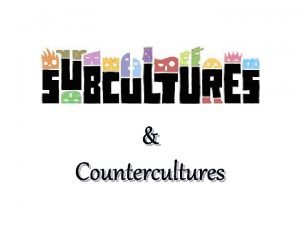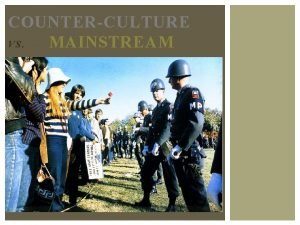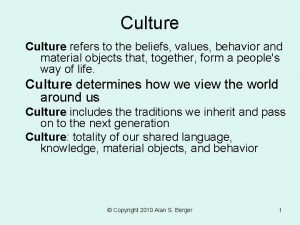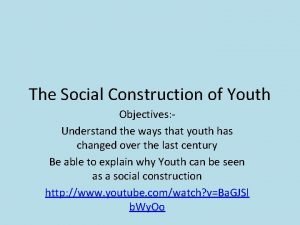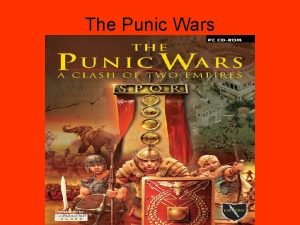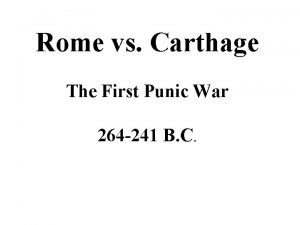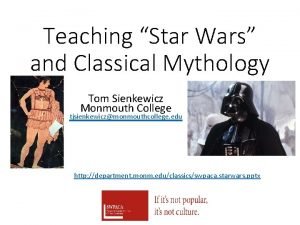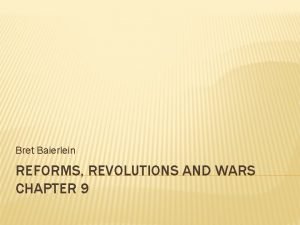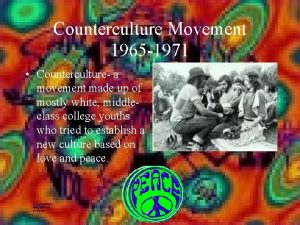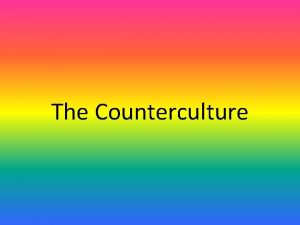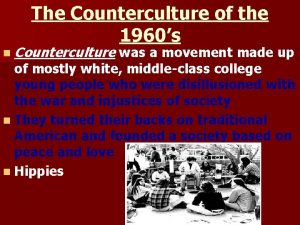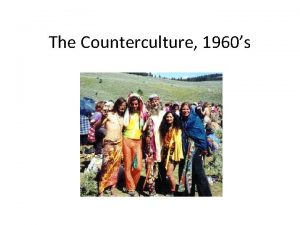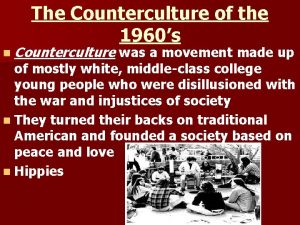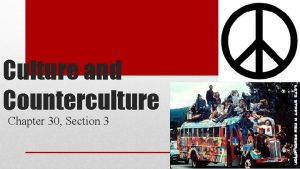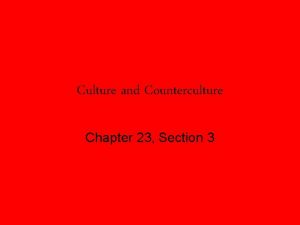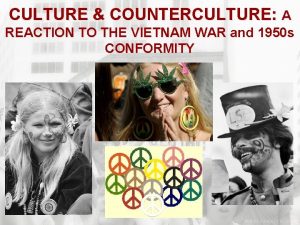Culture Wars Counterculture youth culture and the threat





























- Slides: 29


Culture Wars Counter-culture, youth culture, and the threat of Cultural Imperialism

• Should Canada enforce protection from U. S. content? What are the consequences of acting or not acting in this way? • What is “youth” culture? How have “adults” responded to it in the past and today? • What is “counter-culture”? Counter to what, and who decides?

Cultural Imperialism • What is “cultural imperialism”? – Power, advantage, influence – Gramsci: “cultural hegemony” • Canada had some celebrities (mostly athletes) but media dominated by Hollywood • Canadians reading American magazines and books, watching American TV and movies, listening to American radio and music


U. S. Influence • How much of the media we consume is U. S. based? • Can we always tell the difference, do we notice? • How is it different from Canadian media, our culture? • Cultural similarities, groupings: – – National borders Canada/U. S. ? Urban – rural? West coast - East coast? Young – old? . What “American values” might Canadian politicians

CBC (Canadian Broadcasting Corporation) • Crown Corporation, founded 1936 (radio) • 1949 Massey Commission: Canada needs own TV, focused on education and communication, not profit and entertainment. CBC TV starts 1952. • Government funding (recent cuts) – Less pressure to appease, attract corporate sponsors/advertisers – Motive: not profit

Canadian Content Laws • U. S. shows more popular, children know more about U. S. culture/values than Canadian. • 1968: Canadian Radio-Television and Telecommunications Commission (CRTC) to regulate amount of foreign material broadcast, Canadian content rules.

CRTC Mandate: Canada's Broadcasting Act (Section 3. 1 (d)(iii)) recognizes these differences and declares that the Canadian broadcasting system should, through its programming and the employment opportunities arising out of its operations, serve the needs and interests, and reflect the circumstances and aspirations, of: • Canadian men, women and children, including equal rights, • the linguistic duality and multicultural and multiracial nature of Canadian society, and • the special place of aboriginal people within that society.

Protecting Canadian Culture • 1951: Massey Commission reports that Canada needs protection from U. S. influence • Strengthen national film board (1939) • Canada Council for the Arts, 1957: grants to writers, artists, theatres • New cultural institutions e. g. National Ballet

Canada the Good • • • Protect Canadian culture = what? 1950’s: Conservative culture Stores closed on Sundays Censorship of literature and film Many towns are dry • Begins to change in 1960’s

“The Invention of the Teenager” • Boomers grow up: 60’s • More freedom, mobility, independence • Strong economy: less have to leave school to go to work • Disposable income from part-time jobs: targeted by businesses, advertisers • Style of music, dress, language different than adults • “Don’t trust anyone over 30”





Who is “the Man”? How do you “stick it to” him?


Rock ‘n’ Roll • Mid-1950’s • Shocking to some adults – censorship attempts – Why did the Ed Sullivan Show only show Elvis from the waist up? • TV: image of artists more important, musical guests (Ed Sullivan, Great American Bandstand) • “British Invasion”: Beatles, Rolling Stones • Adult disapproval = more cool?


Ethnicity & Appropriation • “Rock n Roll” – Alan Freed, Cleveland radio disc jockey, 1951 – Uses term to sell black rhythm and blues (R&B) music to a white audience • Elvis: "The colored folks been singing it and playing it just like I'm doing now, man, for more years than I know. I got it from them. Down in Tupelo, Mississippi, I used to hear old Arthur Crudup bang his box the way I do now, and I said if I ever got to the place where I could feel all old Arthur felt, I'd be a music man like nobody ever saw. ” (1956)


Culture: Mainstream, Sub, Counter • TV in 50 s-60 s: mostly white, middle class, nuclear families, traditional values (e. g. Brady Bunch) – What/who is omitted, hidden? • Ethnic and cultural groups not represented • 60 s: groups challenging establishment, “alternative lifestyles” outside of the mainstream – Beatniks, hippies

Culture: Mainstream, Sub, Counter • Sub = group of people that are within a larger dominant culture but differentiate themselves from it • “Counter” to what? • Counter-culture = a subculture that defies major aspects of the dominant culture, opposes mainstream values or cultural mores, substantially different behaviour



Shop it to the Man • Co-option: Find what kids are into, start producing and selling it – capitalize on… eventually becomes “too mainstream” • Every sub/counter culture is a target market under umbrella of consumer culture • Not just buying products that promise to make you look successful, beautiful. Advertiser selling products as edgy, rebellious, dangerous, “bad”, non-conformist • Rebel, revolt, be unique via consumption


“Kids These Days…” • Set in a time period: 50 s/60 s, today, 2050 • Act out a news report on an issue, problem, fear, or complaint that adults would have about teenagers. (A historical example from lecture, a current example, or predict future example). Have one or two reporters, one or two interviewees (e. g. teenager, parent, teacher, doctor, psychologist) • Present: one-two minutes
 1950s conformity and counterculture
1950s conformity and counterculture Counterculture in the philippines
Counterculture in the philippines Subcultures examples
Subcultures examples Counterculture vs subculture
Counterculture vs subculture Examples of countercultures
Examples of countercultures Brethren defintion
Brethren defintion Mainstream vs counterculture
Mainstream vs counterculture The members of the counterculture movement were mostly
The members of the counterculture movement were mostly Beliefs values behavior and material objects
Beliefs values behavior and material objects Objectives of youth culture
Objectives of youth culture The punic wars were fought between
The punic wars were fought between Rome vs carthage
Rome vs carthage Opium wars and boxer rebellion
Opium wars and boxer rebellion Imperial wars and colonial protest
Imperial wars and colonial protest The rise of napoleon and the napoleonic wars
The rise of napoleon and the napoleonic wars Napoleon young
Napoleon young Star wars and greek mythology
Star wars and greek mythology 3 punic wars summary
3 punic wars summary How did the great peloponnesian war end
How did the great peloponnesian war end Wars revolutions and reforms
Wars revolutions and reforms Examples of non material culture
Examples of non material culture Batch culture vs continuous culture
Batch culture vs continuous culture Indian culture vs american culture
Indian culture vs american culture Stab culture and stroke culture
Stab culture and stroke culture Folk culture and popular culture venn diagram
Folk culture and popular culture venn diagram Folk cultures are spread primarily by
Folk cultures are spread primarily by Urease test
Urease test Folk culture and popular culture venn diagram
Folk culture and popular culture venn diagram Lawn culture method
Lawn culture method Describe lawn culture and surface plating
Describe lawn culture and surface plating




